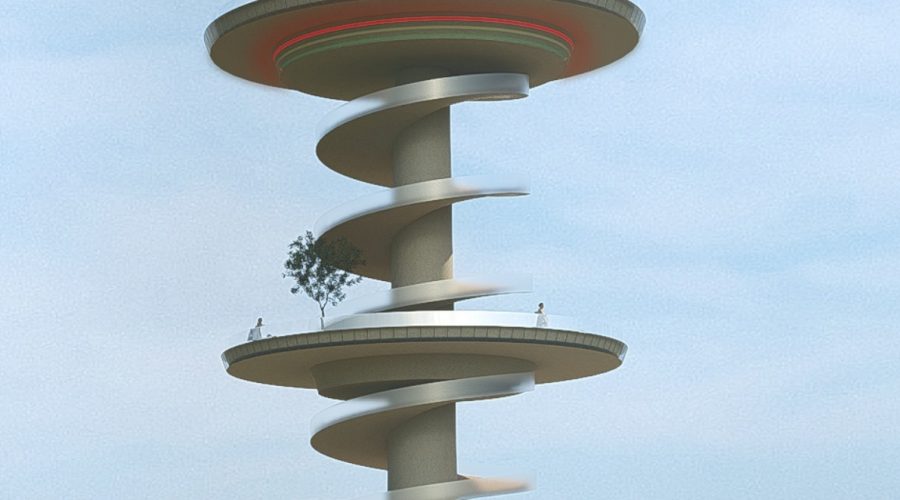Setting the scene:
The apocryphal Place of Last Resort sign at the Aireys shops has most likely faded from our conscious attention; the same is probably true, for all people, for all the similar signs in all the other towns in all Victoria. Yet such signs should be impossible to ignore. They should be everywhere. In every aspect of our lives. For the reality is that we now inhabit a Planet in The Era of Last Resort. Planetary ‘last resort’ signals everywhere – when we allow ourselves to see them. Every day brings new data on climate and biodiversity breakdown, on the disruption of land and ocean systems, on the contamination of the eco-commons that used to sustain us all with clean air, water and food.
Ignoring all those last-resort signals takes increasing emotional effort; it requires us to engage in various forms of focus-distraction. Often, I suspect, it means we adopt some form of guilty ‘prayer’, that the big disaster won’t happen to us, or at least not in our lifetime. The emotional energy required for such ’blanking out’ is taking its toll, showing up everywhere in growing levels of deep eco-anxiety.
Corporations and institutions that derive economic and political power from short-changing the life-support systems of the planet, have taken advantage of desire of citizens to avoid engaging with evidence that the futures they once hoped for are being foreclosed. They have found it so easy to generate noise to distort signals of planetary distress. The more egregious of them engage in the production of deceitful ‘counterevidence’. We also have so many ‘leaders’ who assert that the world of politics and money must always trump science.
One way or another, in the ‘triple bottom line” version of sustainability, the ‘environmental’ and ‘social’ dimensions usually end up being subservient to the ‘economic’. Inevitably the very idea of sustainability has been hollowed out to something akin to slowing down deterioration, leaving the bill for repairing broken natural systems (if that is even possible) to future generations.
It is in this context that the Regenerative Transformation Lab at RMIT (RTL) which I co-lead with colleague Prof Michael Trudgeon, has recently turned its attention to the future for the old Alcoa mine and power plant, right next to the town of Anglesea. Rethinking the use of that site as a focus for nature restoration, for systems repair and climate and biodiversity resilience, accords with a new high-level research theme on regenerative futures adopted by RMIT University.
The RTL is the evolution of almost two decades of work from a precursor body, the Victorian Eco-innovation Lab (VEIL). VEIL was a multi-university ‘real world laboratory’ to “enlist the best of Australia’s design professionals undertaking post graduate education, in the community co-design of futures to respond to the urgent challenges of climate change”. Rethinking the Alcoa site is an apt focus for the continuation of that work. It will take several years. it is currently in an early phase. Such work starts with a process to envision what the site could be, with what-if glimpses of its evolution driven by a new purpose: to offer possibilities of hopeful futures.
As this process has unfolded, I have frequently found myself thinking of it as creating a Place of First Resort – a site for engagement with, and immersion in, the life-affirming project of the restoration of planetary systems.
The Alcoa site – a recent history
Anyone reading this will know of the Alcoa mine and power plant. It shut down in 2015. It has become a remarkable example of on-going restoration by the company, standing in real contrast to the abandoned state of many thousands of other mining sites right across Australia. Many of you will remember as well that Alcoa presented plans for its future as a public space when it announced its closure. The state government developed a zoning plan for ten sections of the site, permitting various conservation, recreation and eco-tourism uses. Then a highly charged proposal known as EDEN Anglesea, was much heralded by Alcoa and its partner, the EDEN centre in Cornwall, UK. EDEN proposed to develop a central section of the site as a themed tourist park, a gated-entry experience space for upwards of 5000 ticket holders per day.
To put it in the nicest possible way, that 2016 EDEN scheme for the site now reads like something from a bygone era. It required hundreds of millions of dollars in private, or state, capital investment. Many significant challenges were never adequately addressed – like transport congestion and where its ‘Place of Last Resort’ would be for 5000 visitors in the event of a wildfire emergency. Its ‘themes’ referenced environmental education, but they now seem so superficial in the context of the urgent challenges facing the Great Ocean Road (GOR) region. It quickly gained the moniker of a ‘Disney-like theme park’.
Our view, echoed by so many Anglesea residents and GOR-related bodies, is that time has created a vacuum in ideas for the future of the site and now is time to fill it with a new vision.
A new approach to rethinking the site.
Over the latter part of last year, the RTL developed a project outline for the site – an open brief for design speculation that drew in an ever-widening group of ‘knowledge partners’ with strong connections to regenerative research and the Great Ocean Road, and a real interest in the ‘the potential of the site as a catalyst for transformation change’.
The initial site ‘brief was quite extensive, but it can be summarised as aiming to:
- Bring about a slow, progressive transformation of the site as a mostly public space development with the community.
- Provide recreation and nature-space opportunities for the people of Anglesea.
- Allocate ‘retreat spaces’ for essential community facilities for Anglesea that will be lost to climate related coastal erosion and sea-level rise.
- Provide for public education, research and experimentation in regenerative futures (with universities and other agencies)
- Create a ‘gateway’ site for the GOR, with a major role to provide, an immersive and transformative experience for visitors, expanding their appreciation of the fragile nature of the GOR region and its deep-time history.
- Act as a hub, able to expose and amplify projects, actions and proposals, across the GOR region (and beyond) that aim for regenerative transformation.
- Support the GOR destination to move rapidly from extractive tourism towards a model that views tourists and tourism providers as regenerative agents; (with tourists’ conscious of the impact of their visitation and acting to restore systems.)
The regenerative tourism focus for the site aligns with the purpose of the Victorian Act that brought the GOR Authority into being: Enshrining a commitment to the protection of the precious history, natural systems and communities of the GOR region and increasing its value as a visitor destination. Regenerative tourism is not a new concept or objective; a Routledge Handbook of Eco-Tourism succinctly quotes a 2018 tourism innovation report from the USA: “sustainability as we know it is dead. Doing less harm is no longer enough. The future of sustainability lies in regeneration: seeking to restore and replenish what we have lost, to build economies and communities that thrive, and that allow the planet to thrive too”. The GOR Authority talks in similar terms of ‘conscious’ tourism.
Learning about regeneration, restoration, replenishment and transformation infuses all components of a new vision for the site. It is all about ‘re-connecting’ broken systems. Pathways allow for local walking and bicycle access from the town. Day visitors and GOR tourists coming by vehicular transport would enter the site via a portal of reality and hope, aimed to sensitise those who pass through to a new appreciation of scale: physical (human/non-human….); temporal (geological /evolutionary/first-nations history/post-colonial land use….). A visitor centre would include exhibition space for creative work on nature and natural systems; there could be offices for local and regional environmental education organisations, facilities for researchers, an auditorium, local regenerative entrepreneurial businesses, and so on.
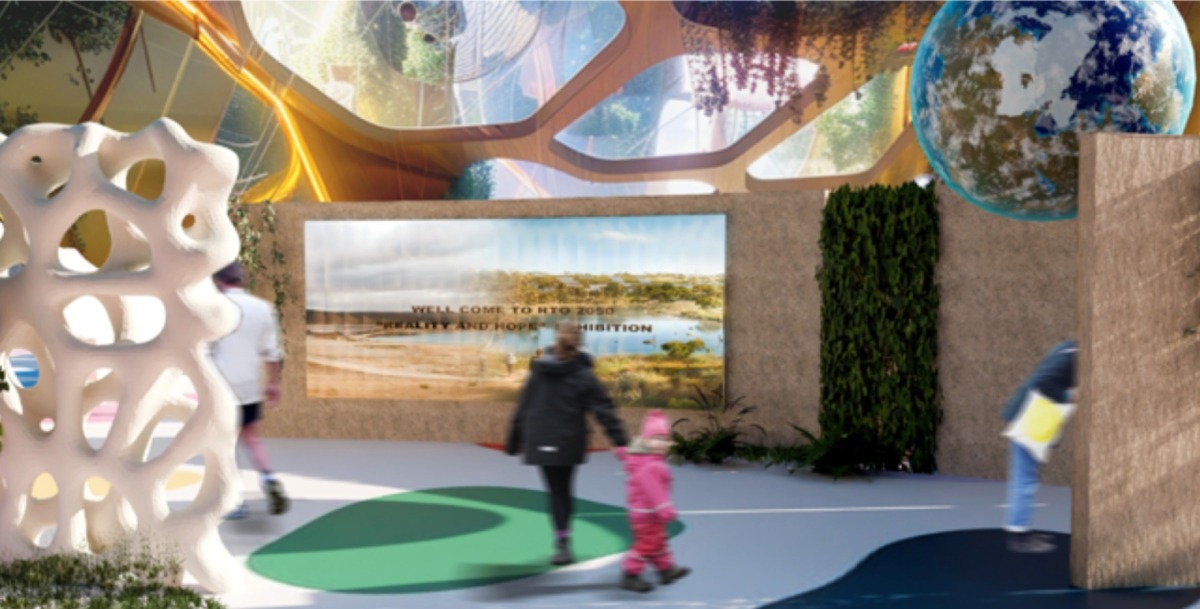
Connection from this site is also to other places regenerative projects, right across the GOR region and beyond. Many of those projects are small and often unobserved outside their local area. We have started a process to ‘map’ them; they span action focused on land and nature, water, food, energy and new ways of living. Many are inspired by, or linked to, aboriginal knowledge and practice.
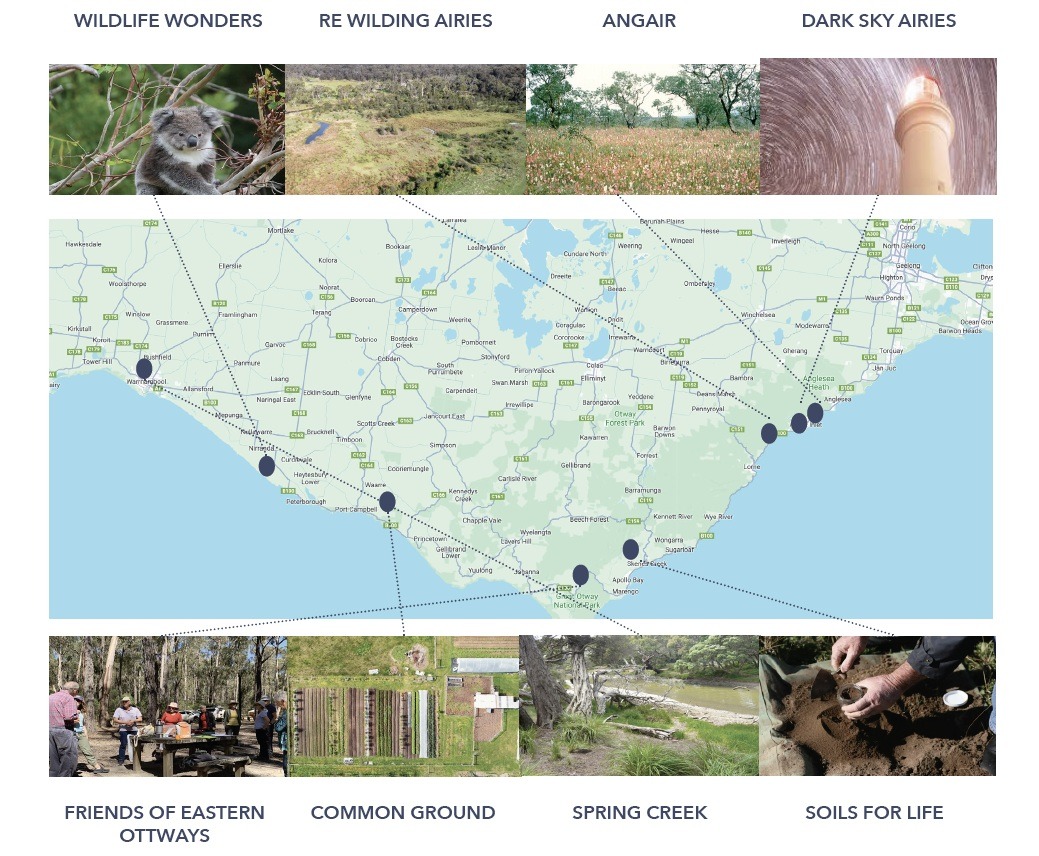
Some features of the future Alcoa site.
All parts of the site – and all the future glimpses of transformation that have been developed – are informed by ideas of connection, storytelling, sharing and learning. Three such ‘glimpses’ illustrate how those ideas and the design objectives could materialise:
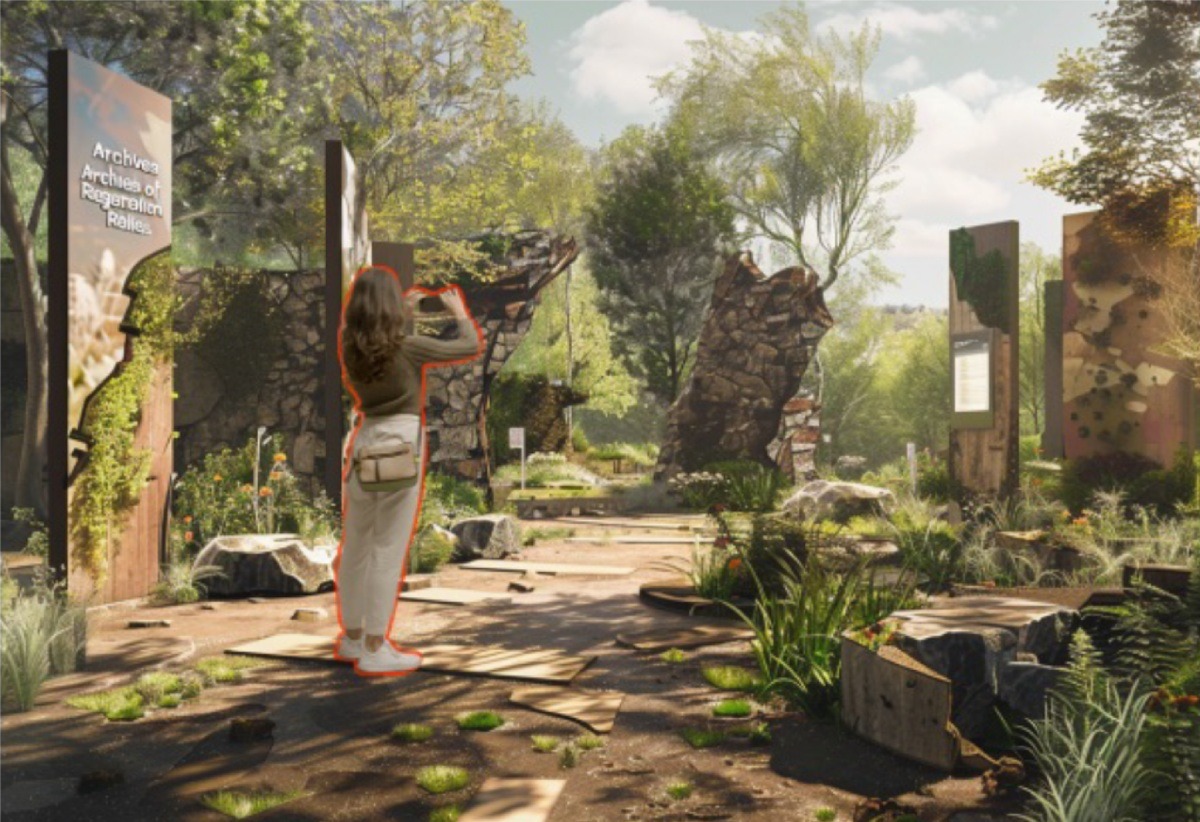
The old Alcoa chimney stack: a Lighthouse and Lookout.
The ‘look out’: Responding to the human desire to climb and see out, the old stack now provides a 360-degree view of the exceptional and the fragile, of the land and ocean ecosystems of the GOR region. Climbing external circular stairs to the top (110m high) brings visitors to a viewing platform.
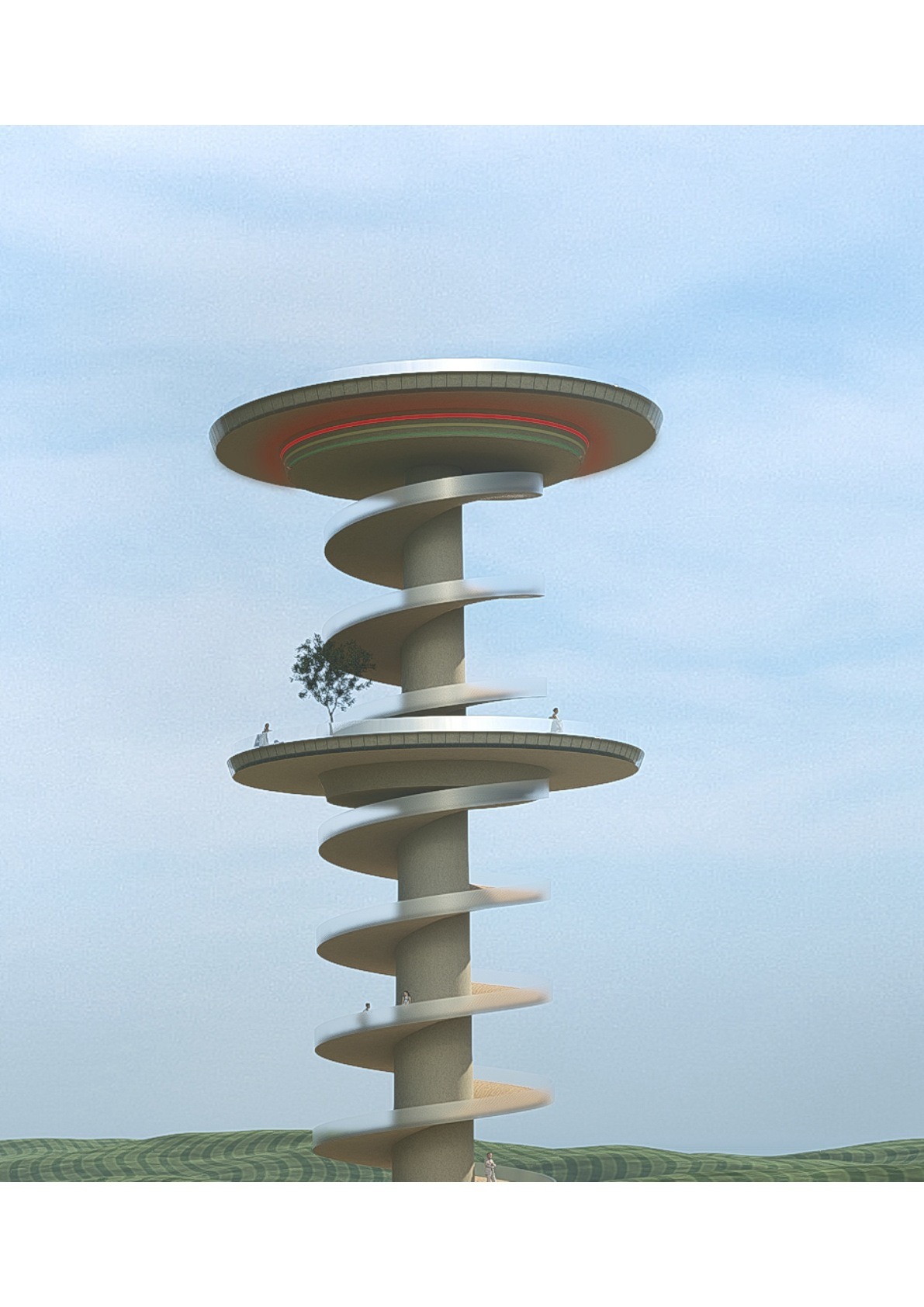 There, through high-tech binoculars, line-of-sight distant views of, for example, Budj Bim, are overlaid with information about what’s ‘in view’, the ecology and cultural history of Tae Rak lake and the aquaculture centre.
There, through high-tech binoculars, line-of-sight distant views of, for example, Budj Bim, are overlaid with information about what’s ‘in view’, the ecology and cultural history of Tae Rak lake and the aquaculture centre.
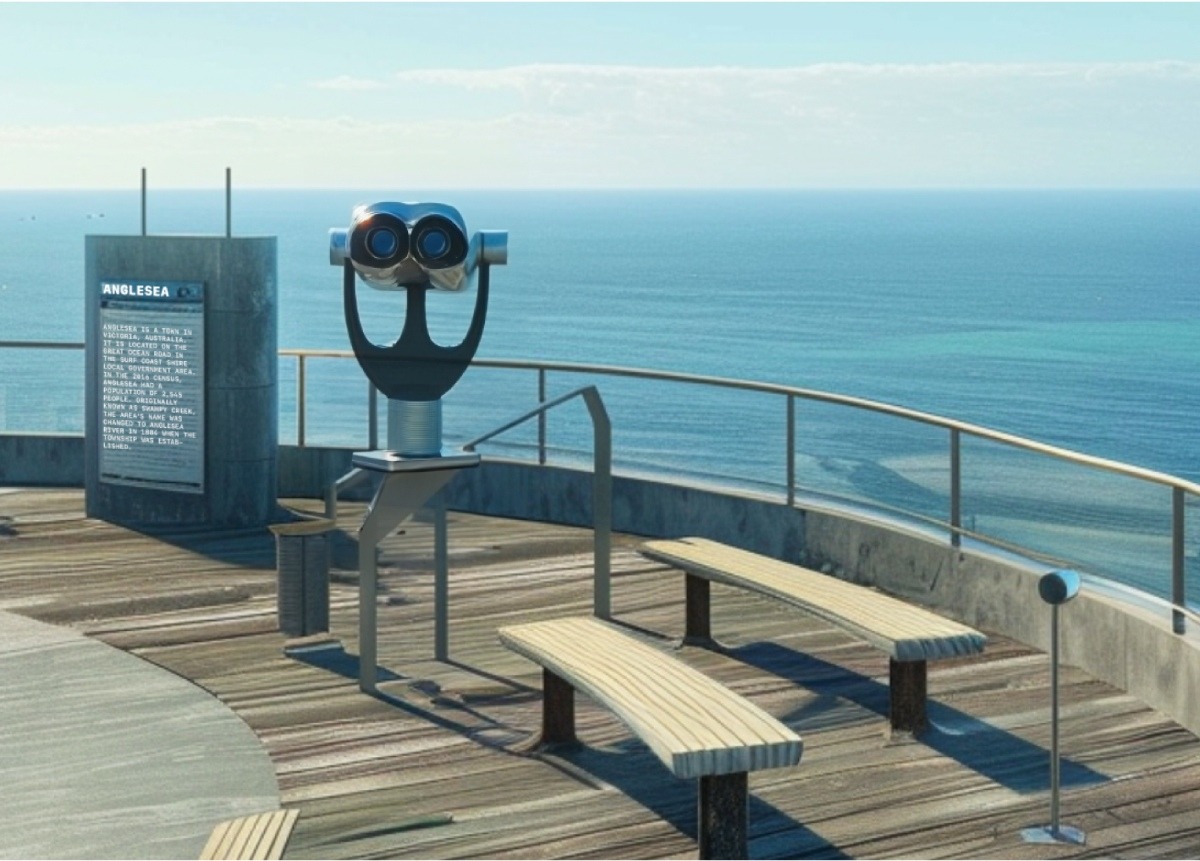 Any sites of regenerative action along a sightline would randomly spring into view – again with overlaid information. For example, ‘viewing’ the Painkalac Estuary could bring into sight the ‘re-wilding’ regeneration project of Lot 2 Bambra Road. ‘Looking onto County’, would present Gunditjmara or Wadawurrung stories of deep time associations with any wedge of land within the binocular’s lenses.
Any sites of regenerative action along a sightline would randomly spring into view – again with overlaid information. For example, ‘viewing’ the Painkalac Estuary could bring into sight the ‘re-wilding’ regeneration project of Lot 2 Bambra Road. ‘Looking onto County’, would present Gunditjmara or Wadawurrung stories of deep time associations with any wedge of land within the binocular’s lenses.
At various points on the lookout platforms there is real-time audio derived from microphones strung in some of the forests, ocean and rivers of the GOR. AI systems help interpret what sounds are produced by what life forms.
For those unable to climb to the lookout, the wall inside of the old stack (over six metres in diameter) displays a feed from the binoculars above for visitors to see what people above are looking at. This is the camera-obscura room of the lookout.
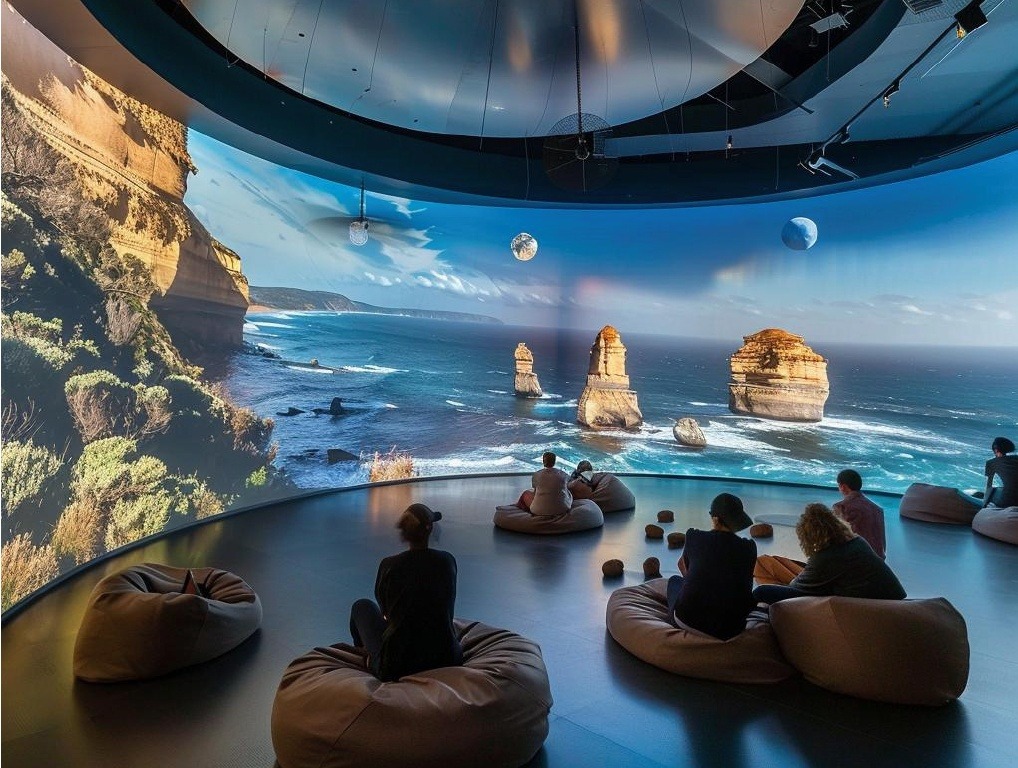
For the lighthouse aspect: On the underside of the top platform – during daylight hours – there is a simple ‘status signal’ whose colour communicates how the GOR region is tracking against critical sustainability indicators. The red light in the image shows that the region is not meeting its state-government legislated greenhouse gas reduction targets. (More detailed information about that data is on display in the Visitors Centre, along with energy production and consumption for the region and its towns, and so on.)
Solar Cultivation.
The large North/NNW/NNS facing slopes above the old mine site and its water body should become a medium-sized solar energy ‘farm’.

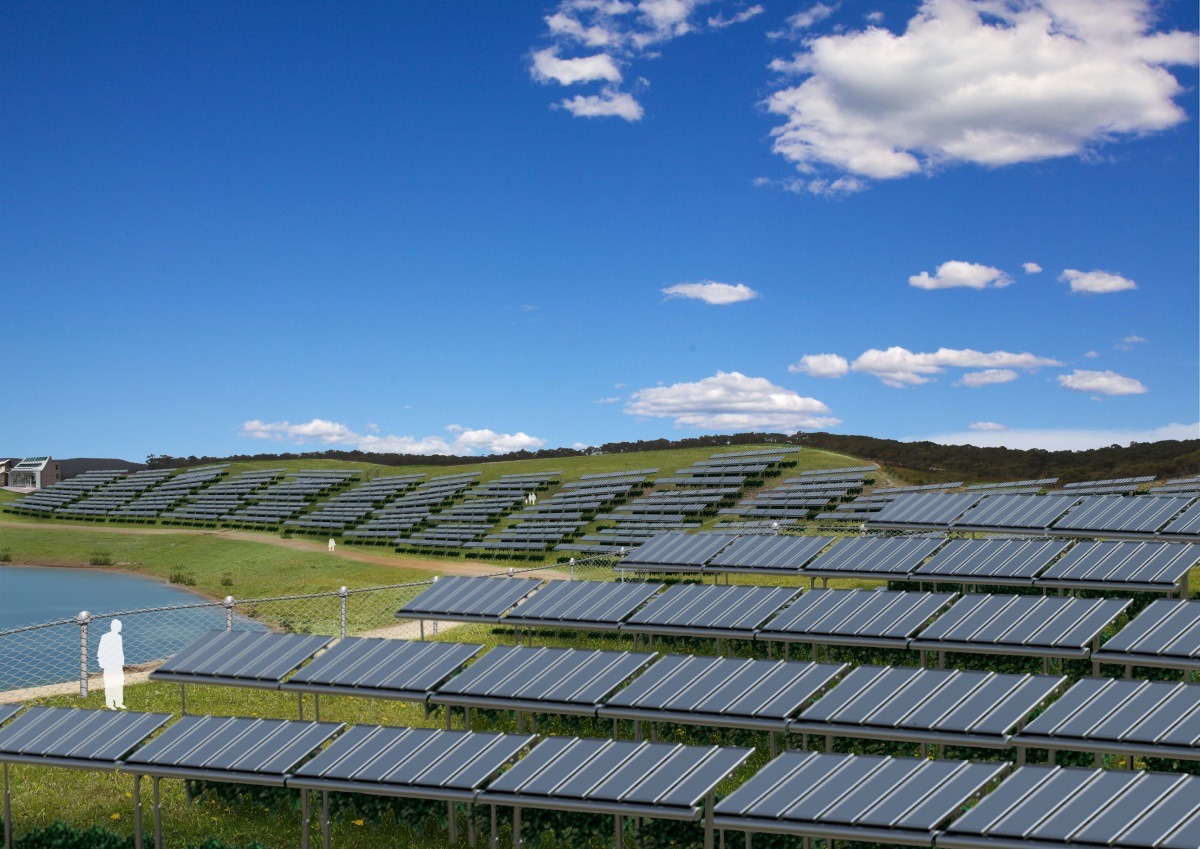 This solar array is specially designed to support vegetation growing under the panels, with enough height to allow ‘farming’. Half of the array has native vegetation under its canopy (linking to an existing revegetated area) with a vermin proof fence providing a sanctuary space for endangered species (of particular interest to some of the project’s knowledge partners). The other half of the array supports horticulture for the site’s cafe.
This solar array is specially designed to support vegetation growing under the panels, with enough height to allow ‘farming’. Half of the array has native vegetation under its canopy (linking to an existing revegetated area) with a vermin proof fence providing a sanctuary space for endangered species (of particular interest to some of the project’s knowledge partners). The other half of the array supports horticulture for the site’s cafe.

There is an energy demonstration centre its the Anglesea end. Amongst general energy information, this centre will feature a countdown to the date when the cumulative renewable energy produced by the solar farm is greater than the cumulative energy generated from fossil fuels during the Alcoa operation.
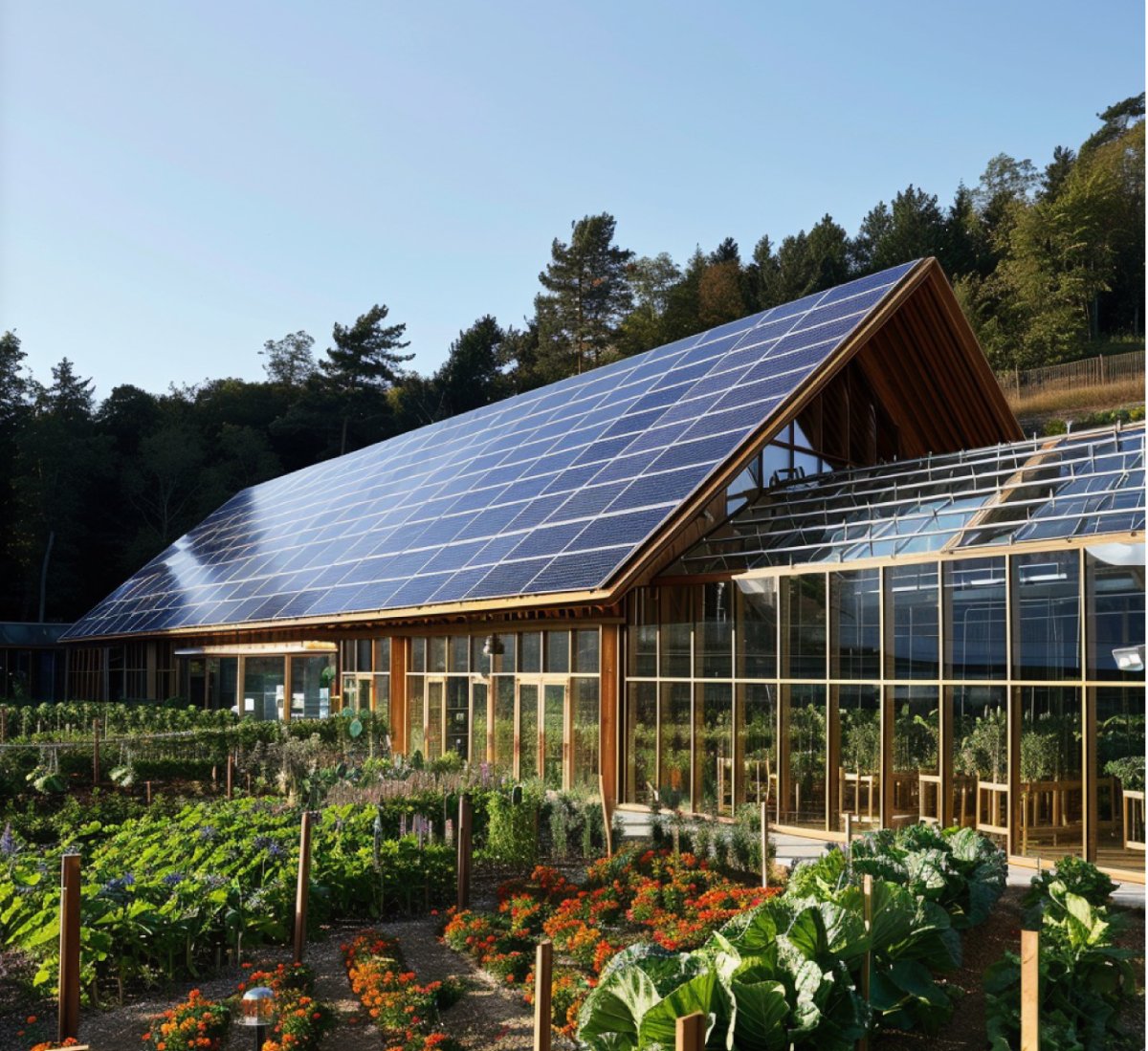
The renewable energy from the array feeds into the Anglesea grid. A local community group have plans to ‘add’ pumped water storage to the system, designed not just to store excess solar energy but to be a demonstration of how simple such a ‘gravity’ battery can be.
Various business models for this solar installation are being explored; options will be presented in the site vision document expected by August this year.
The water body.
Currently the old mine is around 18% filled with water essentially from rainfall. The future ‘lake’ that appears on various plans for the site (and as a feature of the EDEN proposal) would take many decades to fill relying on rainfall. In our visioning, this very slow accumulation of water becomes a feature of the site’s education ambitions (about temporal scales).
The existing water body is quite acidic and not safe for swimming. We envisage ‘fencing it off’ in an ingenious way. A floating boardwalk will be constructed to run around the edge of the existing water. This walkway has a fence on its inner, water, side. Three floating ramps connect that board walk to a cycle/running path that follows the edge of the final lake.
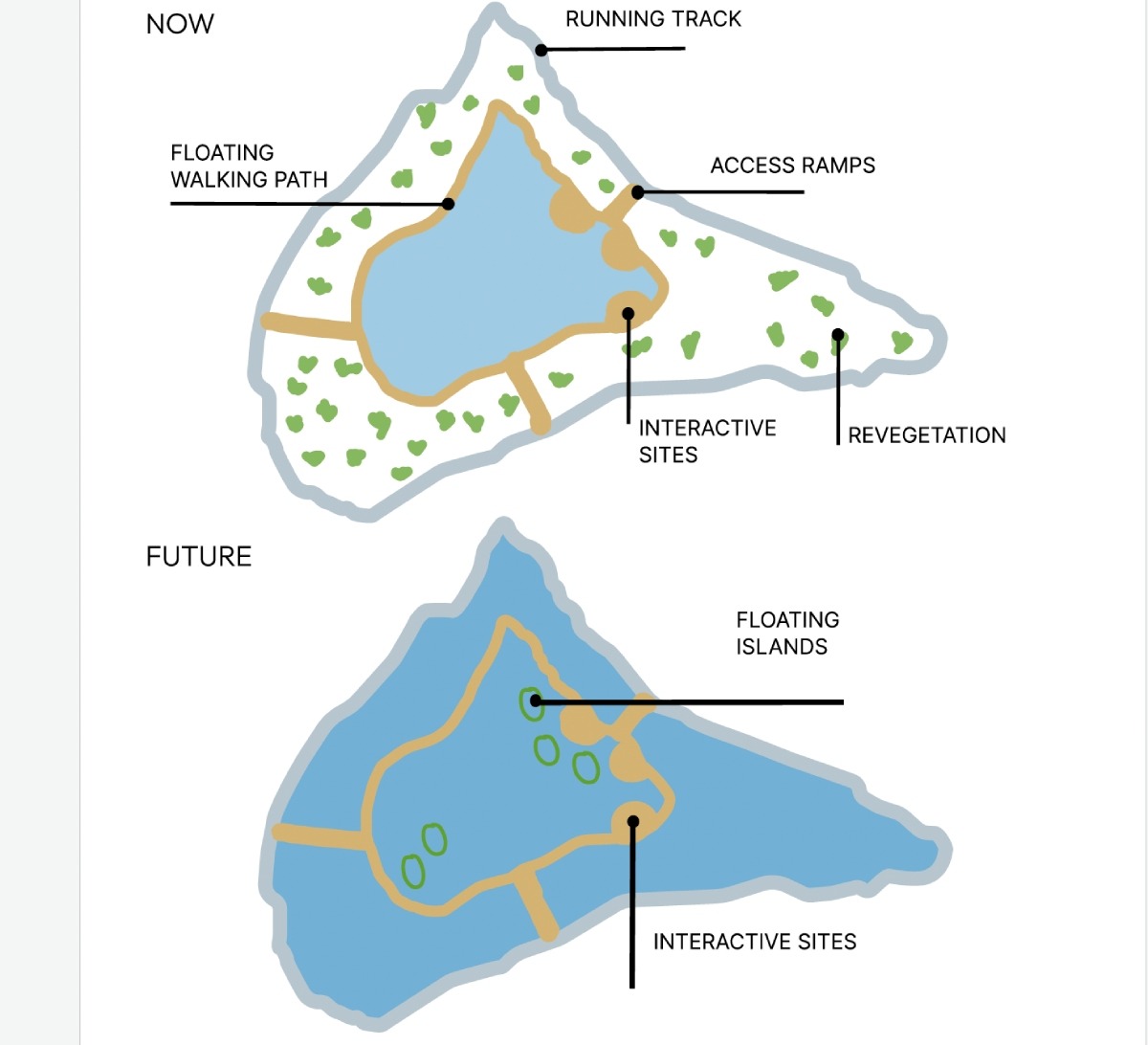
The land between the boardwalk and that ‘final’ water’s edge, will be planted as a community project. As rainfall slowly fills the mine, the boardwalk will start to float and wetlands will develop on the ‘outside’ of the boardwalk. By, say, 2050 the floating boardwalk will show the outline of the ‘old’ water body of 2025 (it will remain fixed in place by those three floating arms connecting it back to the outer running track). Runners and walkers will be able to cross the lake as they run around the floating and fixed paths.
Information along the floating walkway will show data on how much rainfall the site has received, the current water volume, the amount lost by evaporation, the height of its surface relative to sea level, and so on. Back at the Information Centre an ongoing ‘competition’ will invite visitors to guess where the circumference of the slowly filling water body will be in future times.
Various experimental process, undertaken by research partners will attempt to naturally change the PH of the water with information on progress visible to all who venture out on the boardwalk. Local residents have suggested the creation of floating gardens to demonstrate what plants can live with acidic water. Such gardens could reduce evaporation.
Note – about filling the water body. Many readers will know that Alcoa (and EDEN) have had plans to fill the mine quickly with water from sources other than rainfall. There are current proposals that suggest that extraction of water from a nearby aquifer could be a way to fill the ‘lake’ within a decade. Such proposals are naturally beset with uncertainties. We have assumed that, at a time when climate change is making rainfall patters more and more uncertain, a social licence to extract water to fill the mine (as distinct from using it for farming for example) would be hard to achieve. Anglsea and Aireys are currently experiencing a period of unexpectedly low rainfall and with climate uncertainties will increase across the country. At this time aquifers and underground basins are very much in focus when it comes to extraction of water or mining activities that could lead to contamination and the unexpected transport of pollution.
Any project focused on regenerative action is surely required to explore design options and futures that would to alleviate the need to fill the mine from sources other than rainfall. Our proposal (which will be the focus for much more detailed design later this year) is one solution that avoids the need to pursue processes of water acquisition that could generate community, scientific and political debate about access to a resource that is always emotionally charged.
Then there is more:
Other intriguing proposals include:
- A ‘networked Botanical Garden’ – linked to all those post-colonial botanical gardens that had an important civic place in the development of regional towns across Victoria.
- A Wadawurrung Arboretum.
- A retreat space for the (GORCAPA owned) Anglesea campground.
- Research centres for: soil-carbon and wetlands; mycelium; regenerative tourism and citizen science; citizen contribution to data gathering for the GOR.

For those who know of the CERES project in Brunswick: think of the future Alcoa site as CERES mark 2.0.
Next:
After feedback and more community ideas for this broad conception for the site there will be further iterations with design teams to explore what might be possible. One such iteration will involve a collaboration of one of the project’s knowledge partners, AURECON, working in global teams starting in October 2024.
Fill the space with ideas and proposals!!
Emeritus Professor Chris Ryan
